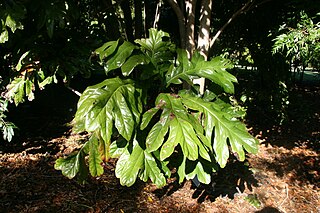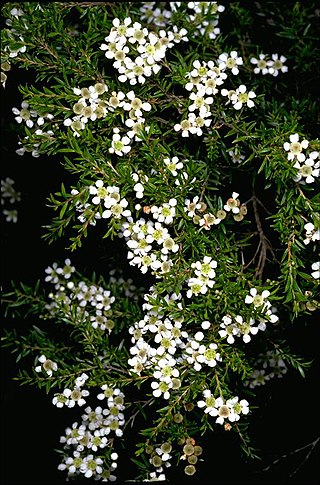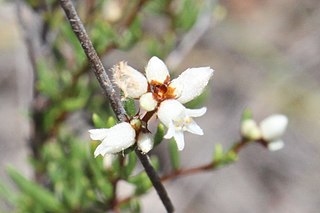
Athertonia is a monotypic genus of plants in the family Proteaceae. The sole described species is Athertonia diversifolia, commonly known as Atherton oak, athertonia, creamy silky oak or white oak. It is endemic to a small part of the Wet Tropics of Queensland, Australia. A relative of the macadamia, it has potential in horticulture and the bushfood industry.

Argophyllum is a genus in the Argophyllaceae family comprising eighteen species of shrubs and small trees. They feature alternate, simple leaves, often silvery white underneath. They appear in Australia and New Caledonia, where several species are nickel hyperaccumulators.

Sannantha similis is a species in the myrtle family, Myrtaceae and is endemic to eastern Australia. It is a shrub with narrowly lance-shaped leaves, and groups of three white flowers arranged in leaf axils.

Zieria fraseri is a plant in the citrus family Rutaceae and is endemic to eastern Australia. It is a dense, bushy shrub with leaves composed of three leaflets, and white flowers with four petals and four stamens. It usually grows in rocky places on steep hills.

Boronia forsteri is a plant in the citrus family Rutaceae and is endemic to mountain ranges in central Queensland, Australia. It is an erect shrub with many branches, simple leaves with a densely hairy, pale underside, and pink, four-petalled flowers.
Sally T. Reynolds is an Australian botanist.

Phebalium longifolium is a species of shrub that is endemic to far north Queensland. It is more or less covered with silvery to rust-coloured scales and has smooth branchlets, narrow elliptical to narrow lance-shaped leaves and cream-coloured flowers in umbels on the ends of branchlets. It grows in the boundary between forest and rainforest in tropical areas.

Argophyllum curtum is a plant in the Argophyllaceae family endemic to a small part of north eastern Queensland. It was described and named in 2018.
Argophyllum loxotrichum is a plant in the Argophyllaceae family endemic to a small part of north eastern Queensland. It was described and named in 2018.
Argophyllum lejourdanii is a plant in the Argophyllaceae family endemic to a part of north eastern Queensland, Australia. It was described and named in 1863.
Argophyllum ferrugineum is a plant in the Argophyllaceae family endemic to a small part of north eastern Queensland. It was described and named in 2018.
Argophyllum heterodontum is a plant in the Argophyllaceae family endemic to a small part of north eastern Queensland. It was described and named in 2018.
Argophyllum iridescens is a plant in the Argophyllaceae family endemic to a small part of north eastern Queensland. It was described and named in 2018.
Cryptandra ciliata is a species of flowering plant in the family Rhamnaceae and is endemic to south-eastern Queensland. It is a shrub with clustered linear leaves and densely-hairy, white, tube-shaped flowers.

Cryptandra debilis is a species of flowering plant in the family Rhamnaceae and is endemic to north Queensland. It is a small shrub with clustered, linear leaves and densely-hairy, white, tube-shaped flowers.

Alstonia muelleriana is a tree in the dogbane family Apocynaceae which is native to southern Papua New Guinea and northeastern Queensland.

Pandanus gemmifer, commonly known as pup pandan, is a plant in the family Pandanaceae that is endemic to northeast Queensland. It is closely related to Pandanus grayorum and Pandanus solms-laubachii.
Androcalva beeronensis is a species of flowering plant in the family Malvaceae and is endemic to Queensland. It is a shrub that forms suckers from rhizomes and has branchlets and leaves covered with soft, golden hairs, the leaves egg-shaped to lance-shaped with toothed edges, and clusters of 9 to 24 cream-coloured to white flowers.
Androcalva inglewoodensis is a species of flowering plant in the family Malvaceae and is endemic to south-eastern Queensland. It is a spreading, prostrate shrub that has hairy young branchlets, egg-shaped to elliptic leaves with irregularly serrated edges, and small groups of white to cream-coloured flowers.

Argophyllum cryptophlebum is a plant in the Argophyllaceae family endemic to a small part of north eastern Queensland. It was described and named in 1907.














